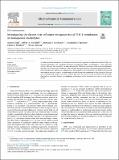Investigating the factors that influence resistance rise of PIM-1 membranes in nonaqueous electrolytes
Author(s)
Gigli, Matteo; Kowalski, Jeffrey A; Neyhouse, Bertrand J; D'Epifanio, Alessandra; Brushett, Fikile R; Licoccia, Silvia; ... Show more Show less
DownloadPublished version (860.8Kb)
Publisher with Creative Commons License
Publisher with Creative Commons License
Creative Commons Attribution
Terms of use
Metadata
Show full item recordAbstract
© 2019 The Authors As redox active macromolecules are introduced to the materials repertoire of redox flow batteries (RFBs), nanoporous membranes, such as polymers of intrinsic microporosity (PIMs), are emerging as a viable separation strategy. Although their selectivity has been demonstrated, PIM-based membranes suffer from time-dependent resistance rise in nonaqueous electrolytes. Here, we study this phenomenon as a function of membrane thickness, electrolyte flow rate, and solvent washing using a diagnostic flow cell configuration. We find that the rate and magnitude of resistance rise can be significantly reduced through the combination of low electrolyte flow rate and solvent prewash. Further, our results indicate that, since the increase is not associated with irreversible chemical and structural changes, the membrane performance can be recovered via ex-situ or in-situ solvent washes.
Date issued
2019Department
Massachusetts Institute of Technology. Department of Chemical EngineeringJournal
Electrochemistry Communications
Publisher
Elsevier BV